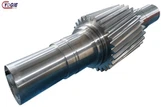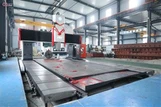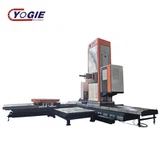Luoyang Yujie Industry&Trade Co., Ltd is one of the most experienced manufacturers and suppliers of screw conveyor shaft in China. Please feel free to buy cheap screw conveyor shaft for sale here from our factory. All customized products are with high quality and competitive price.
Products Description
A screw conveyor shaft is a central component of a screw conveyor system, which is a commonly used mechanical conveying device for moving bulk materials, powders, granules, and other substances from one location to another. The screw conveyor shaft plays a critical role in the operation of the conveyor and is designed to withstand the stresses and forces associated with the conveying process.
main features of a screw conveyor shaft
Shaft Material: Screw conveyor shafts are typically made from durable materials such as stainless steel, carbon steel, or other corrosion-resistant alloys, depending on the specific application and the material being conveyed.
Diameter and Length: The diameter and length of the screw conveyor shaft depend on factors such as the material properties, conveyor capacity, and the distance over which the material needs to be transported. Larger diameters and longer shafts are used for higher-capacity systems.
Screw Design: The shaft is equipped with a helical screw blade that is attached along its length. The shape, pitch, and diameter of the screw blade can vary to suit different materials and conveying requirements. Different screw designs can provide better mixing, controlled flow, or even convey delicate materials without causing damage.
Mounting and Bearings: The shaft is supported by bearings at both ends to ensure smooth rotation. The bearings are usually housed in bearing hangers or end bearing supports, which help distribute the load and prevent excessive wear on the shaft and bearings.
Sealing Mechanisms: To prevent leakage of materials or dust, sealing mechanisms are often used around the entry and exit points of the screw conveyor. These seals help maintain the integrity of the material being conveyed and prevent environmental contamination.
functions of a screw conveyor shaft
Material Conveying: The primary function of a screw conveyor shaft is to facilitate the movement of bulk materials from one point to another. The screw blade's rotation creates a continuous, axial flow that pushes the material along the trough or tube of the conveyor.
Mixing and Blending: In some applications, the helical screw blade design can be optimized for mixing or blending different materials during the conveying process. This is particularly useful when combining multiple ingredients to achieve a consistent mixture.
Controlled Flow: Screw conveyors can be designed to provide precise control over the material flow rate. This is important when handling materials that need to be metered accurately for processing or packaging.
Handling Various Materials: Screw conveyors are versatile and can handle a wide range of materials, including dry powders, granules, flakes, pellets, and even semi-fluid materials.
Vertical Conveying: In addition to horizontal conveying, screw conveyors can also be used for vertical conveying, making them suitable for various industrial applications where space constraints exist.
Summary
Overall, the screw conveyor shaft is a critical component that determines the performance and efficiency of the screw conveyor system. Proper design, material selection, and maintenance are essential to ensure smooth operation and a long service life.
Hot Tags: screw conveyor shaft, manufacturers, supplier, factory, customized, cheap, price, in stock, for sale















